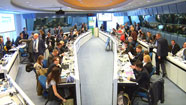On 5 April 2016 the JRC presented the interactive and collaborative online European Energy Efficiency Platform. This beta platform is conceived to fill the gap opened by scattered data and fragmented knowledge resulting from a rapidly growing energy efficiency market. It is expected to be both a one-stop shop for information retrieval and a meeting point for experts to exchange data and reduce redundant activities.
Renewable energy in Europe for climate change mitigation

Greenhouse gas emission savings due to renewable energy (2009-12)
Policy context
The EU has made a unilateral commitment to reduce in 2020 the overall greenhouse gas (GHG) emissions from its Member States by 20% compared to 1990 levels putting a legally binding target of 20 % of gross final energy consumption (GFEC) from renewable energy sources.
In October 2014 the Commission proposed a climate and energy policy framework for 2030 that included a target of reducing emissions to 40 % below 1990 levels and increasing the proportion of renewable energy in the EU’s energy consumption to at least 27 %.
On 25 February 2015, the European Commission set out the EU's vision for the new global climate change agreement. "The Paris Protocol-a blueprint for tackling global climate change beyond 2020” in the EU’s Energy Union package will be adopted in Paris in December 2015.
For 2050, EU leaders have endorsed the objective of reducing Europe’s GHG emissions by 80-95 % compared with 1990 levels, as part of similar joint efforts by developed countries.
Key conclusions
Renewable energy has a large potential in the portfolio of climate change mitigation displacing the fossil fuel used in power and heat sectors. Setting up the 20% target for GHG emissions reduction up to 2020 drove an increase in renewable energy share in the EU-28, from 8.5% in the baseline year to 11.9% in 2009 and furthermore to 14.1% in 2012, a development that was accompanied by an increase of nearly 9% each year in greenhouse gas emission savings in the EU.
The fast penetration of wind and solar power in European energy mix resulted to have the highest contribution in climate change mitigation in European Union between 2009 and 2012 cementing the position of renewables as an indispensable part of the European energy mix.
Main findings

In EU net GHG emission savings by renewables increased between 2009 and 2012 from 529.4 Mt CO2eq to 716 Mt CO2eq.
Net GHG emission savings per person in EU ranged from 1.05 Mt CO2eq/capita in 2009 to 1.42 Mt CO2eq/capita in 2012.At European Union level in 2012 the proportion of GHG emission savings due to renewable electricity and heat/cold rose to 38% (682.2 Mt CO2eq) of GHG emissions reduction for this year and accounting to nearly 13% of GHG emissions released (4546 Mt CO2eq). In 2012 energy related GHG emissions were affected to almost 17% by the renewable power and heat development in EU.
Related and future JRC work
The JRC has released a set of reports on renewable energy progress based on national renewable energy action plans (NREAPs) and bi-annual progress reports in order to analyse how the burden sharing for the 2020 renewable energy targets is going currently and is expected to look like in the coming years.
JRC has established a database on national renewable energy action plans and progress reports submitted every two year which is going to become an integral part of a Knowledge Centre (KC) to support the implementation of the Energy Union Strategy




To quote this article use the follonwing format: